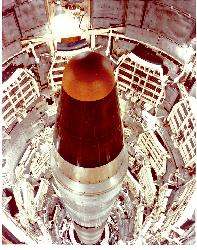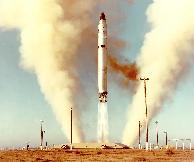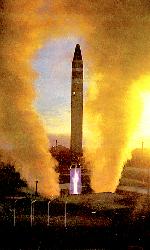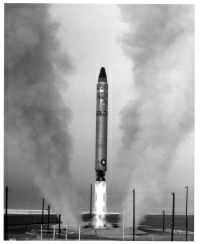The Titan II weapon system fits into the same category as the B-36 bomber, which was never used in an armed conflict but did fulfill its mission. The Titan II has also fulfilled its mission.
 The mission of the Titan II weapon system was deterrence. It has never been the intent of the United States to launch a nuclear-tipped missile against another nation. To be an effective deterrent, a weapon system must possess a high degree of reliability and accuracy. The philosophy of deterrence encompasses the idea that the retaliatory capability of an armed force is of sufficient magnitude to make the cost of armed aggression prohibitive. Over the years the Titan II had proved its worth as an element in the United States deterrent force on the basis of its reliability and capabilities.
The mission of the Titan II weapon system was deterrence. It has never been the intent of the United States to launch a nuclear-tipped missile against another nation. To be an effective deterrent, a weapon system must possess a high degree of reliability and accuracy. The philosophy of deterrence encompasses the idea that the retaliatory capability of an armed force is of sufficient magnitude to make the cost of armed aggression prohibitive. Over the years the Titan II had proved its worth as an element in the United States deterrent force on the basis of its reliability and capabilities. The Titan II missile system was designed to destroy enemy strategic targets in a minimum of time. To do so, the warhead must be placed on a target with a high degree of accuracy and from a distance of over 5500 miles. This degree of accuracy is comparable to your throwing a golf ball into the mouth of a teacup 150 yards away. It is obvious that many variables must be considered in attaining this degree of accuracy. The powered portion of flight lasts less than one-sixth of the total flight time. Control of the flightpath was not possible after powered flight ends. So all factors such as velocity, attitude, and altitude must be attained before the end of powered flight to permit the warhead to freefall to the target. All missile systems exist solely for this purpose.
The Titan II missile system was designed to destroy enemy strategic targets in a minimum of time. To do so, the warhead must be placed on a target with a high degree of accuracy and from a distance of over 5500 miles. This degree of accuracy is comparable to your throwing a golf ball into the mouth of a teacup 150 yards away. It is obvious that many variables must be considered in attaining this degree of accuracy. The powered portion of flight lasts less than one-sixth of the total flight time. Control of the flightpath was not possible after powered flight ends. So all factors such as velocity, attitude, and altitude must be attained before the end of powered flight to permit the warhead to freefall to the target. All missile systems exist solely for this purpose. US Air Force Photo, by J. Fuller
US Air Force Photo, by J. Fuller US Air Force Photo, 1369th Photo Sq.
US Air Force Photo, 1369th Photo Sq.